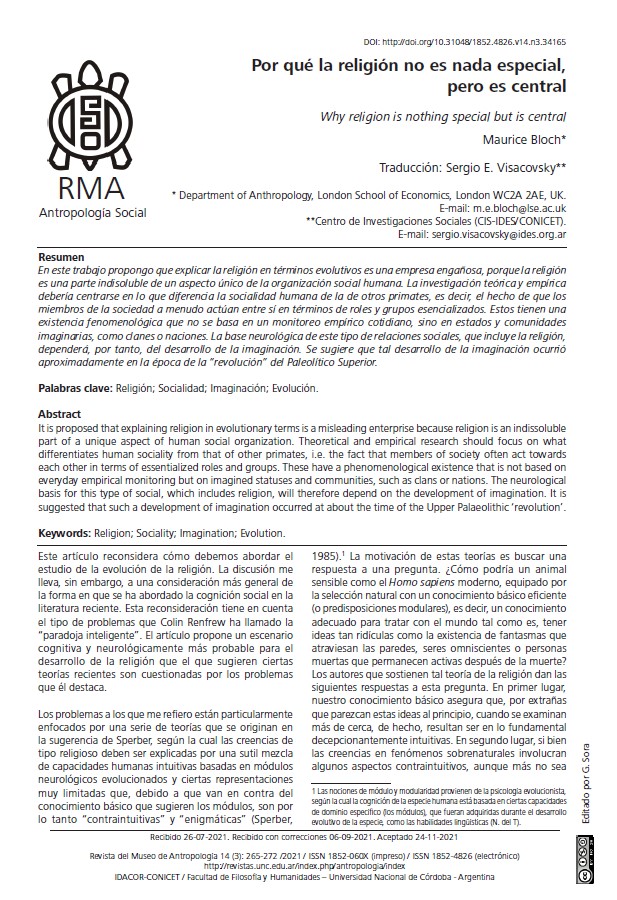Por que a religião não é nada especial, mas é central
DOI:
https://doi.org/10.31048/1852.4826.v14.n3.34165Palavras-chave:
Religião, Socialidade, Imaginação, EvoluçãoResumo
Neste artigo, é proposto que explicar a religião em termos evolucionários é um empreendimento enganoso, porque a religião é uma parte indissolúvel de um aspecto único da organização social humana. A pesquisa teórica e empírica deve enfocar o que diferencia a sociabilidade humana daquela de outros primatas, isto é, que os membros da sociedade frequentemente agem uns com os outros em termos de papéis e grupos essencializados. Estes têm uma existência fenomenológica que não se baseia no monitoramento empírico cotidiano, mas em estados e comunidades imaginários, como clãs ou nações. A base neurológica dessa categoria de relações sociais, que inclui a religião, dependerá, portanto, do desenvolvimento da imaginação. Sugere-se que tal desenvolvimento da imaginação ocorreu por volta da época da "revolução" do Paleolítico Superior.
Downloads
Referências
Andersen, Benedict. (1983) Imagined communities: reflections on the origin and the spread of nationalism. London, UK: Verso.
Barrett, Justin L. (2004) Why would anyone believe in god? Walnut Creek, CA: Alta Mira Press.
Beard, Mary, John North y Simon Price. (1998) Religions of Rome, vol. 2. Cambridge, UK: Cambridge University Press.
Bloch, Maurice. (1986) From blessing to violence: history and ideology in the circumcision ritual of the Merina of Madagascar. Cambridge, UK: Cambridge University Press.
Bloch, Maurice. (1995) “The symbolism of tombs and houses in Austronesian societies with reference to two Malagasy cases”. Austronesian Studies August: 1–26.
Boyer, Pascal. (1994) The naturalness of religious ideas: a cognitive theory of religion. Berkeley, CA: University of California Press.
Boyer, Pascal. (2001) Religion explained: the evolutionary origins of religious thought. New York, NY: Basic Books.
De Waal, Frans. (2000) Chimpanzee politics: power and sex among apes. Baltimore, MD: Johns Hopkins University Press.
Dunbar, Robin. (2004) The human story. London, UK: Faber and Faber.
Evans-Pritchard, Edward Evan. (1948) The divine kingship of the Shilluk of the Nilotic Sudan. Cambridge, UK: Cambridge University Press.
Feeley-Harnik, Gillian. (1991) The green estate: restoring independence in Madagascar. Washington, DC: Smithsonian Institution Press.
Fuller, Christopher John. (1992) The camphor flame: popular Hinduism and society in India. Princeton, NJ: Princeton University Press.
Frankfort, Henri. (1948) Kingship and the gods. Chicago, IL: Chicago University Press.
Harris, Paul L. (2000) The work of the imagination: understanding children’s world. Oxford, UK: Blackwell.
Kopytoff, Igor. (1971) “Ancestors as elders”. Africa 41: 129–142.
Middelton, John. (1960) Lugbara religion. London, UK: Oxford University Press.
Nelson, Janet L. (1987) “The Lord’s anointed or the people’s choice: Carolingian royal rituals”. Cannadine, David y Simon Price (eds.) Rituals of royalty: power and ceremonial in traditional societies (pp. 137–180). Cambridge, UK: Cambridge University Press.
Pyysiainen, Ilkka. (2001) How religion works. Leiden, The Netherlands: Brill.
Radcliffe-Brown, Alfred Reginald. (1952) Structure and function in primitive society. London, UK: Cohen and West.
Rakoczy, Hannes. (2007) “Play, games and the development of collective intentionality”. Kalish, Charles W. y Mark A. Sabbagh (eds.) Conventionality in cognitive development: how children acquire representations in language thought and action (pp. 53–67). New directions in child and adolescent development, no. 115. San Francisco: Jossey-Bass.
Smith, Jonathan Z. (1982) Imagining religion: from Babylon to Jonestown. Chicago, IL: University of Chicago Press.
Sperber, Dan. (1985) “Anthropology and psychology: towards an epidemiology of representations”. Man (N.S.) 20: 73–89.
Wengrow, David. (2006) The archaeology of early Egypt. Social transformations in north-east Africa, 10,000–2,650 BC. Cambridge, UK: Cambridge University Press.

Downloads
Publicado
Edição
Seção
Licença
Copyright (c) 2021 Sergio Visaconvsky

Este trabalho está licenciado sob uma licença Creative Commons Attribution-NonCommercial-ShareAlike 4.0 International License.
Os autores que têm publicações nesta revista aceitam os seguintes termos:
a. Os autores reterão os seus direitos autorais e garantirão à revista o direito de primeira publicação do seu trabalho, que estará sujeito à Licença de Atribuição Creative Commons (Licencia de reconocimiento de Creative Commons), que permite que terceiros compartilhem o trabalho enquanto o seu autor e a sua primeira publicação nesta revista.
b. Os autores podem adotar outros contratos de licença não exclusivos para a distribuição da versão do trabalho publicado (por exemplo, depositá-lo num arquivo eletrônico institucional ou publicá-lo num volume monográfico), desde que a publicação inicial nesta revista seja indicada.
v. É permitido e recomendado aos autores que divulguem os seus trabalhos na Internet (por exemplo, arquivos telemáticos institucionais ou no seu site) antes e durante o processo de envio, o que pode levar a trocas interessantes e aumentar citações do trabalho publicado. (Veja El efecto del acceso abierto - O efeito do acesso aberto.)











